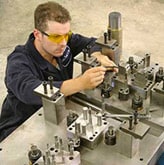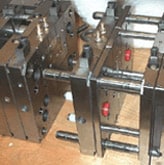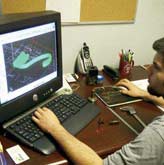(click on thumbnail to enlarge)
Injection Mold Design Services
Injection molding is a cost-effective method to create extremely complex molded plastic parts. Incorporating accurate, precise designs prevents costly errors during the injection mold process. Understanding all aspects of injection molding tooling design is essential to extending your parts’ service life and usability. Here we’ll discuss how injection molding works, as well as the applications and benefits of the process.
What Is Injection Molding?
Injection molding is a precision manufacturing process that involves injecting liquid plastic into a custom-designed mold. The plastic starts off as solid granules that are heated and pressurized by a screw press. The molten plastic flows through runners in the mold cavities, filling the mold. There, the material hardens and forms the shape of the final product.
Controlling the injection molding process requires specialized machinery and skilled operators that understand how different plastics behave under these conditions. More complex parts require more complex molds or additional molding processes.
Here are the main considerations to take into account throughout the injection molding process.
Material
When the plastic material flows through the injection mold machine, its molecular properties may resist the flow into a cramped mold. This resistance can cause air pockets in the final product. Having the correct injection mold material, wall thickness, and tooling plays a key role in the quality of the final product.
Draft
Because of the contact between the molded part and the mold cavity, it can be tricky to remove the product from the mold without damaging the part surface. For this reason, mold designers add draft angles or tapers to the mold cavity so that the product is easy to remove. The exact degree of the draft depends on the surface finish, level of shrinkage, texture, and depth of the mold.
Radii
In addition to drafts, we add internal and external radii to round off sharp corners that can warp and damage the walls of a part when it is removed from the mold. Radii help molten plastic flow throughout the mold, ensuring the integrity of the final molded product.
Core Out
We core out molded parts by making them hollow, using ribbing and supporting gussets to provide stability. This cost-effective technique uses less material, reduces mass, and maintains the part’s original strength and structure.
Undercuts/No Undercuts
Molded parts with undercuts—indentations or protrusions—tend to be more complex because they cannot be ejected from the mold using conventional methods. Usually, this means the mold must come with a side-pull mechanism, which would cost more for the overall injection molding operation. Another option is to use manually removable inserts, where the part is ejected with an insert that an operator must remove by hand and replace in the mold. Generally, designers should either refine the product design to eliminate undercuts or find a way to make the existing design as efficient as possible.
Injection Mold Design Benefits and Applications
Because of its versatility across nearly every industry, injection molding and design services are growing in demand and popularity.
Benefits of Injection Mold Design
Here are some of the key benefits of injection molding.
- Precision: Injection molding mass produces precision parts for demanding industries such as medical, automotive, and aerospace.
- Complexity: Injection mold designs can accommodate minute details and complex shapes while keeping costs low and production smooth.
- Durability: Injection molded plastic parts can be made strong and durable. The process allows the addition of fillers to create less dense, more durable products.
- Automation: Automation is a key factor for producing quality parts at a steady rate, keeping fulfillment and product delivery on schedule.
- Cost-effectiveness: Injection molding processes are among the most economical processes for manufacturing plastic parts. The final cost depends on the materials used, type of injection molding process, and mold complexity, but generally injection molding still beats other methods in terms of cost.
- Material variety: The diverse materials and colors available for injection molding allow customers to fully customize their manufacturing process. They can choose from plastics and thermoplastic rubbers that are biodegradable, chemically resistant, or have various finishes.
- Reduced material waste: Injection-molded plastics produce nearly zero material waste, and material that is not used in the molding process can be repurposed for other projects.
Applications for Injection Molding
Here are the major industries taking advantage of injection molding:
- Food and beverage
- Automotive
- Medical
- Pharmaceutical
- Agricultural
- Electronics
- Aerospace
- Marine
- Construction
Injection Mold Design Services from Lerner Molded Plastics
Lerner Molded Plastics has over 35 years of experience in designing custom molds and tools. Our capabilities extend into all types of plastic molding processes, including injection molding, rotational molding, blow molding, thermoforming, and extrusion. Our ISO 9000:2000 certification ensures quality management, reporting, inspection, approval, and sampling of all products.
At Lerner Molded Plastics, we use the latest technologies and specialize in part design for injection molding. Contact us today for more information on how we can help you create your precision plastic parts, or request a quote for your project.
Portfolio
Precision Mold Design & Tool Making Capabilities
| General Mold Design & Tool Making Capabilities |
|
||
| Sourcing Locations |
US Overseas |
||
| Mold Types |
|
||
| Tooling | Checking Fixtures Assembly Fixture |
||
| Material Form | Cast Machined |
||
| Material Applications | Steel Stainless Steel Aluminum |
||
| Secondary Services | In-Line or Post Molded Secondary Assembly Ultrasonic Welding Part Decorating (Hot Stamping, Pad Printing, Painting) Bar Coding and Labeling Complete Packout Services Warehousing Services and Drop Ship Capability All Material, Packaging, and Components Sourcing Complete Supply Chain Services Product Distribution Logistics Engineering Product Development Mold Making Tooling Vendor Managed Inventory Programs Kanban |
Additional Information
| Industry Focus |
|
||
| Intended Application |
|
||
| Industry Standards | ISO Certified | ||
| File Formats | SolidWorks Pro-Engineer |





